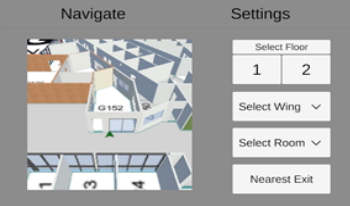
During emergencies, accurate and timely dissemination of evacuation information plays a critical role in saving lives and minimizing damage. As technology continues to advance, there is an increasing need to explore innovative approaches that enhance emergency evacuation and navigation in an indoor environment to facilitate efficient decision-making. This paper presents a mobile augmented reality application (MARA) for indoor emergency evacuation and navigation in a building environment in real time. The location of the user is determined by the device camera and translated to a position within a Digital Twin of the Building. AI-generated navigation meshes and augmented reality foundation image tracking technology are used for localization. Through the visualization of integrated geographic information systems and real-time data analysis, the proposed MARA provides the current location of the person, the number of exits, and user-specific personalized evacuation routes. The MARA can also be used for acquiring spatial analysis, situational awareness, and visual communication. In emergencies such as fire and smoke visibility becomes poor inside the building. The proposed MARA provides information to support effective decision-making for both building occupants and emergency responders during emergencies.

There is a need to prepare for emergencies such as active shooter events. Emergency response training drills and exercises are necessary to train for such events as we are unable to predict when emergencies do occur. There has been progress in understanding human behavior, unpredictability, human motion synthesis, crowd dynamics, and their relationships with active shooter events, but challenges remain. This paper presents an immersive security personnel training module for active shooter events in an indoor building. We have created an experimental platform for conducting active shooter drills for training that gives a fully immersive feel of the situation and allow one to perform virtual evacuation drills. The security personnel training module also incorporates four sub-modules namely 1) Situational assessment module, 2) Individual officer intervention module, 3) Team Response Module, and 4) Rescue Task Force module. We have developed an immersive virtual reality training module for active shooter events using an Oculus for course of action, visualization, and situational awareness for active shooter events as shown in Fig.1. The immersive security personnel training module aims to get information about the emergency situation inside the building. The dispatched officer will verify the active shooter situation in the building. The security personnel should find a safe zone in the building and secure the people in that area. The security personnel should also find the number and location of persons in possible jeopardy. Upon completion of the initial assessment, the first security personnel shall advise communications and request resources as deemed necessary. This will allow determining whether to take immediate action alone or with another officer or wait until additional resources are available. After successfully gathering the information, the personnel needs to update the info to their officer through a communication device.

During active shooter events or emergencies, the ability of security personnel to respond appropriately to the situation is driven by pre-existing knowledge and skills, but also depends upon their state of mind and familiarity with similar scenarios. Human behavior becomes unpredictable when it comes to making a decision in emergency situations. The cost and risk of determining these human behavior characteristics in emergency situations is very high. This paper presents an immersive collaborative virtual reality (VR) environment for performing virtual building evacuation drills and active shooter training scenarios using Oculus Rift headmounted displays. The collaborative immersive environment is implemented in Unity 3D and is based on run, hide, and fight mode for emergency response. The immersive collaborative VR environment also offers a unique method for training in emergencies for campus safety. The participant can enter the collaborative VR environment setup on the cloud and participate in the active shooter response training environment, which leads to considerable cost advantages over large-scale real-life exercises. A presence questionnaire in the user study was used to evaluate the effectiveness of our immersive training module. The results show that a majority of users agreed that their sense of presence was increased when using the immersive emergency response training module for a building evacuation environment.

During emergencies communicating in multi-level built environment becomes challenging because architectural complexity can create problems with visual and mental representation of 3D space. Our Hololens application gives a visual representation of a building on campus in 3D space, allowing people to see where exits are in the building as well as creating alerts for anomalous behavior for emergency response such as active shooter, fire, and smoke. It also gives path to the various exits; shortest path to the exits as well as directions to a safe zone from their current position. The augmented reality (AR) application was developed in Unity 3D for Microsoft HoloLens and also is deployed on tablets and smartphones. It is a fast and robust marker detection technique inspired by the use of Vuforia AR library. Our aim is to enhance the evacuation process by ensuring that all building patrons know all of the building exits and how to get to them, which improves evacuation time and eradicates the injuries and fatalities occurring during indoor crises such as building fires and active shooter events. We have incorporated existing permanent features in the building as markers for the AR application to trigger the floor plan and subsequent location of the person in the building. This work also describes the system architecture as well as the design and implementation of this AR application to leverage HoloLens for building evacuation purposes. We believe that AR technologies like HoloLens could be adopted for all building evacuating strategies during emergencies as it offers a more enriched experience in navigating large-scale environments.